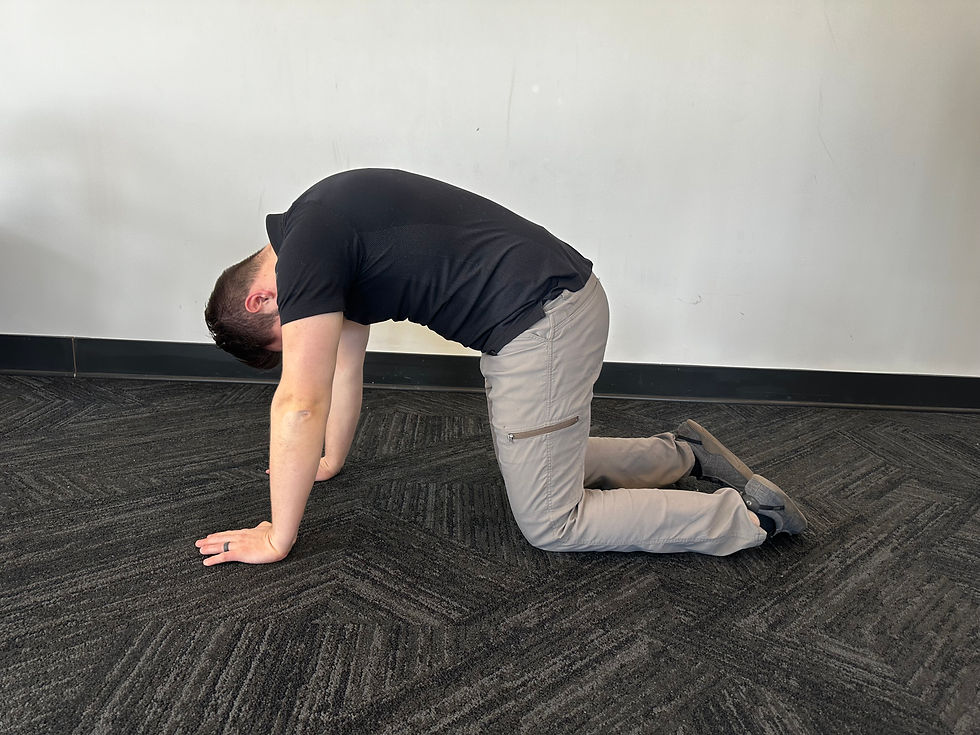World's Greatest Stretch
- Benjamin Mishleau
- Jan 23, 2025
- 3 min read
Updated: Feb 20, 2025
The World’s Greatest Stretch, often abbreviated as WGS, emerged as a dynamic warm-up exercise in athletic training and functional fitness. Its exact origins are unclear, but it gained widespread popularity in the early 2000s as coaches and trainers sought efficient, full-body movements to enhance mobility, flexibility, and athletic performance. Praised for its ability to target multiple muscle groups and joints, it has become a staple in warm-ups and mobility routines across sports, fitness, and rehabilitation settings.
Purpose: The WGS targets multiple muscle groups, making it ideal for preparing the body for athletic activity or enhancing overall mobility.
Targeted Areas: Hip flexors, hamstrings, glutes, thoracic spine
Instructions:
Start in a high plank position with your hands under your shoulders and your body in a straight line.
Step your right foot forward, placing it outside your right hand. Your back leg should remain extended.
Lower your left knee (optional) to the ground for a modified version or keep it off the floor for a greater challenge.
Rotate your torso to the right, extending your right arm upward toward the ceiling while keeping your left hand planted. Hold for a few seconds.
On exhalation, gently swing your right arm down and underneath your body, twisting your body down and to the left.
Perform 8–12 repetitions for 2–3 sets on each side.
Tips:
Move slowly and with control to maximize the stretch and avoid injury.
Keep your core engaged and back neutral throughout the movement.
Breathe deeply to relax into each position.
Who Should Do the World's Greatest Stretch?
The world’s greatest stretch is a dynamic, full-body stretch that targets the hips, hamstrings, chest, and spine. It is ideal for:
Athletes & Active Individuals: A great warm-up exercise for athletes in sports like running, football, and cycling as it activates key muscles and improves flexibility in multiple areas.
People with Tight Hips and Hamstrings: The stretch helps improve flexibility and mobility in the hips, hamstrings, and lower back, making it beneficial for individuals with tightness in these areas.
Individuals Seeking Full-Body Mobility: The World’s Greatest Stretch is excellent for people looking to improve overall flexibility, especially in the lower body, spine, and shoulders, and to increase range of motion.
Those Preparing for Intense Exercise: It’s an effective dynamic stretch to perform before strength training, HIIT, or any activity that requires joint mobility and flexibility.
People with Desk Jobs or Sedentary Lifestyles: Those who sit for long periods benefit from this stretch, as it helps to open up the hips and improve posture, which can be negatively affected by sitting all day.
Who Should Avoid or Modify the World’s Greatest Stretch?
While beneficial for many, the World’s Greatest Stretch may not be suitable for everyone, especially for individuals with specific conditions or limitations:
People with Severe Hip or Lower Back Injuries: Since the stretch involves deep hip flexion and rotation, it may aggravate hip or lower back issues such as herniated discs, sciatica, or hip labral tears. It may need to be modified or avoided if these conditions are present.
Individuals with Knee Problems: The deep lunge position in the stretch places stress on the knees, particularly if there are existing knee injuries like patellar tendinitis or ligament instability. Modifying the depth of the lunge or avoiding the exercise may be necessary for those with knee pain.
People with Shoulder Injuries: While the world’s greatest stretch can open up the chest and shoulders, the position may put strain on the shoulders, particularly if there’s existing shoulder discomfort, rotator cuff issues, or instability. Modifying the range of motion or avoiding the stretch may be advised for those with shoulder problems.
Pregnant Women (Later Stages): Due to the deep lunging and spinal rotation, the stretch might not be comfortable in later stages of pregnancy. Alternative stretches with less strain on the abdominal and pelvic areas may be recommended.
Individuals with Balance or Stability Issues: Those who have difficulty balancing or lack flexibility may find this stretch challenging. Beginners or individuals with stability issues should perform the stretch with caution, possibly using a wall or chair for support.
People with Severe Sciatica or Nerve Impingement: If there’s nerve impingement or severe sciatica, the deep lunge and spinal movements may exacerbate symptoms, particularly during the hip flexion phase. It’s important to modify the stretch or avoid it if nerve issues are present.
If It Causes Pain: If in doubt, if it causes pain, don't do it.









Comments